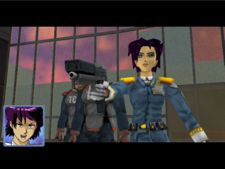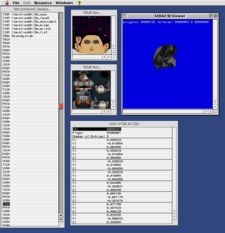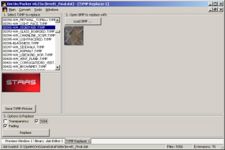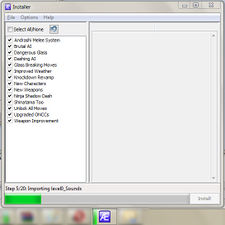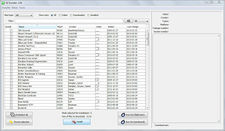History of Oni modding
- This article is a historical perspective on Oni modding; for an introduction to how to actually mod Oni, see here. To download mods, you can start here.
As has been documented on the page about Oni's overall development, time ran out for Bungie West to do everything they wanted with this very ambitious game. Just as some features had to be omitted, the promise of modding support[1] also failed to come true. However, even before Oni fans realized that there would never be official modding tools from Bungie, they were already eagerly diving into the game data to see how they could mod it.[2] Nevertheless, the lack of any documentation or tools for modding undeniably slowed the development of mods within the community. Only since 2010 has the community's modding capabilities covered nearly all aspects of the game.
There are three basic areas in which the game can be modded: scripting, binary resources, and the engine itself. Along the way, we'll look at some key discoveries the community made in more detail.
BSL scripting
Since the .bsl files were in plain text and in plain sight within the folders that held Oni's game data, it's not surprising that fans quickly learned some basic scripting commands by seeing what Bungie had written, and started making their own scripts. Further commands were discovered by dumping readable text from the engine, although not everything worked as it seemed it should.
As scripters were learning BSL, they produced scripts that at first merely modified the original level logic in minor ways. Then they produced more original, often epic fight scripts; later, some ambitious modders scripted totally new objectives and mission layouts (e.g., Mariachi Bear's alternate storyline). Some of the most complex scripts are the OTA scripts which were eventually developed to make up for a lack of multiplayer gameplay.
However, fully original scripts are all the more prone to bugs. The first two are easier to set up, but extreme situations tend to overload the engine (as in "Blam!") in ways that scripters have trouble preventing. Testing the scripts required numerous reloads of the game. The process became much faster when the Developer Mode console was unlocked (see § Finding Dev Mode) and individual commands could be tested easily.
While scripting is the easiest way to mod Oni, it's also the most limited, because scripts can only utilize the resources that the vanilla level has to offer.
Binary resources
Private knowledge, public results
Fans with some expertise in parsing files with hex editors found that the level data files held four-letter codes indicating the start of each resource within that file. Before Oni even released, the community had its first resource modding tool, Ian Patterson's OniTools. While the author did not yet know how all the data worked, his program could at least parse it, and allow the modder to more easily edit each resource without having to count in hexadecimal. It also supported user-friendly replacement of texture maps, delta patches called CMPOs, and allowed inline viewing of the game's 3D models. There seems to be little evidence that this knowledge was put to use in modding the game resources beyond simple texture replacements, no doubt due to the lack of a complete understanding of how Oni's dozens of resource types were interrelated. But the open-source release of OniTools gave fans something to build on.
Independently, an intrepid programmer named Pierre Terdiman decided to import data from Oni into the game engine that he was writing from scratch. Called Konoko Payne, it was a long-term project which took the form of (1) an underlying engine and (2) a short scenario for it that resembled a sequel to Oni. In order to extract models and animations from Oni and recreate them precisely in his project, Pierre became one of the early pioneers in reverse-engineering the game's resources, although his acquired knowledge remained largely private as the engine was closed-source.
Hackers unite
Perhaps the first place that knowledge of Oni's data was directly published online was on Oni Master's site, which started as early as 2003 and was based on the source code for OniTools. Then, in 2005, Ssg opened a site with a much more thorough examination of the game data (the site is now hosted at http://ssg.oni2.net). Later that year, this pool of knowledge was painstakingly moved by geyser and Ssg to its final home on the newly-opened wiki OniGalore. The purpose of creating the Oni Binary Database was to allow collaboration, and soon Neo appeared on the scene, adding his own knowledge that he had been acquiring independently until then, and collaborating on further investigations into the resource formats. Today at least 95% of the binary resource formats are documented byte for byte thanks to their hard work.
- Further reading: History of the Oni community § 2005.
Modding by candlelight
Originally, modders had to alter these binary resources manually with hex editors to adapt them to their scripts. Loser was the first modder to manually edit the game data to go along with his scripting, creating a massively reshuffled Warehouse. Loser's Warehouse mod included a global component (modified level0_Final), level-specific binary modifications, and a set of customized scripts that took full advantage of the modified binaries.
Minor binary modding had already occurred before Loser's Warehouse (thus, while compiling the OBD database, Ssg had released a version of level0_Final in which all of Konoko's combos were unlocked). Still, it was the Warehouse mod released in 2005 which first showed the "full" potential of binary modding. It inspired a short-lived initiative called the Binary Improvement Project (BIP), aimed at providing upgraded binaries for all levels, not just level0_Final and level1_Final.
BIP was hindered by large upload/download sizes as well as by the potential legal issues involved in distributing entire files from the game; in 2006 it was replaced by a smarter alternative to supplying whole levels, in the form of OniUnPacker-based patches, and was termed Oni ni Kanabô (ONK). The modder would edit his .dat/.raw files in OUP, and then release a single binary resource patch. This was both bandwidth-efficient and more legal-friendly, but suffered from one major limitation: the indexation and offsets of data vary a lot across the available versions of Oni. Thus, resources exported with OUP were not truly standalone or portable. Also, OUP still lacked the ability to import new resources alongside existing ones.
Modular modding
The advent of Neo's OniSplit in late 2007 marked a radical improvement to the community's modding methods. A command-line tool that runs on Windows and Macs, OniSplit breaks Oni's resources into standalone files, making mods truly portable across different retail versions of Oni. These resources can be exported to standard formats as text, images, sounds and 3D models, which after editing can be recombined into the level data files that Oni expects, and newly-made resources can also be packed into the level data. To take advantage of this revolution in modding, geyser began preparing an OniSplit-based port of some of the work done on BIP and ONK, which he hoped would be ready for the seventh anniversary of Oni's release in January 2008.
This "Seventh Anniversary Edition" had major releases in January and July 2008. The tradition continued of using a central modding project to organize a general revision of Oni's content, as seen on pages like AE:Ninja. The project then changed hands to Gumby, who designed a framework and a GUI-based installer that allowed players to selectively install only the modifications that they wanted. This mostly moved the project away from a centralized improvement effort, though select mods were still bundled with the download. Since Oni's seventh anniversary had come and gone, the mod collection was renamed simply the "Anniversary Edition", aka the "Edition" or the "AE". Released in July 2009, the new AE's framework allowed modders to create their own "mod packages". These could be stored on the Oni Mod Depot, then downloaded by the player and placed in a certain folder in order to see them in the Installer. Another release was made in May 2010 with more bundled mods and an improved framework.
Nothing new took place on this front until 2013, by which time the project had fallen into Iritscen's hands due to the retirement of geyser and Gumby. At this time, the release of the new AE included a brand-new Installer written by Alloc which could connect to the Mod Depot, offer all mod packages for download, and update the mods and patches already installed. The program XmlTools was developed by s10k to allow "patch modding" of resources in order to avoid conflicts when different mods attempted to modify the same resource. The AE's bundled content was stripped down to only minimal fixes for the first time, making all notable game modifications into optional third-party mods and ceasing any attempt at centralized game data improvement.
New content
Certain game resources were easy enough to reverse-engineer that the community was able to mod them almost from the time of Oni's release, such as textual resources and textures. Some game resources, however, were complex and involved multiple data types, such as character models, and, most obviously, levels themselves. These took a number of years to decipher.
OniSplit first gained the ability to import new character models in April 2008.[3] At first, since the focus was on the technical side of things, pre-existing models were used, either by modifying Oni's models, or by finding royalty-free models on web sites and converting them to Oni's 19-bone system. A more dramatic use of the character-importing ability came with the creation of a high-detail Konoko model from scratch in October 2010.[4]
A major obstacle with levels was the question of how to generate pathfinding (PF) grids for the AI. Level geometry could be imported fairly easily as of November 2008,[5] but AIs could not navigate the level. Manual PF grid creation was first demonstrated with the creation of the Arena level in November 2010.[6] Automatic PF grid generation was introduced to OniSplit around June 2011. More comprehensive demonstrations of the community's level creation abilities came with EdT's level "Muro's Lair" in August 2011[7] and Samer's level "Wilderness Preserve" in January 2014.[8]
Work continues in all areas of modding Oni, as well as documenting the modding process.
Engine patching
Finding Dev Mode
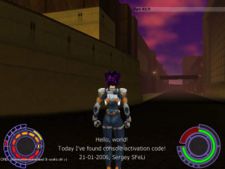
Engine patching is needed when modders want to do things the game's scripts and data do not currently allow for, as well as to fix bugs. Bug fixes were the earliest notable achievement in engine patching, originally performed by a patching application that altered the Windows Oni executable directly, but a revolution in this type of modding occurred in 2006 when Developer Mode was finally discovered in retail Oni's code, and a means for unlocking it was needed.
The most foolproof method of altering the engine turned out to be replacing a library that Oni loads at runtime. Originally this was done by placing a library next to Oni.exe called vtuneapi.dll, which contained code written by SFeLi that would replace or patch functions in Oni. This library came to be known as the Daodan DLL. The code for it was ported from assembly language to C by RossyMiles. Eventually the decision was made to instead replace binkw32.dll (the library for playing Oni's intro and outro movies) because it loaded earlier in Oni's launch sequence. The DLL was later developed by Gumby and then Alloc, fixing more bugs (some of which result from modern computers running a 24-year-old game), as well as adding new features. The DLL's features and settings are documented on the page for the DLL linked above.
Not long after the Daodan DLL was released for Windows Oni, it was discovered that the Mac versions of Oni still had Dev Mode in them, too. Instead of replacing the Bink Carbon Library that came with Mac Oni, the Omni Group port of the game application to Mac OS X was patched directly with a hex editor. In the fall of 2008, it was discovered that numerous BSL functions and variables that were thought to be removed from Oni for the Mac before release were still present in the code, and the ones which allowed Macs to run (almost) all scripts written for Windows Oni were "unlocked" by EdT using hex edits. Certain changes made by the Daodan DLL for the Windows version were also carried over to the Mac's PPC game application in hex-edit form with Neo's assistance. Later, these changes were made in source for Feral Interactive's Mac Intel port.
Bug fixes
One of the most visible changes to the game that the Daodan DLL (and equivalent hex edits on the Mac side) made possible came about in July '07 when an error in Oni's AI routines was corrected by Neo, allowing the AI to dodge incoming fire more consistently. Fans had originally been disappointed to see the AI often run blindly into oncoming gunfire. With Neo's patch in place, previously glitched code now works as intended, allowing the AI to dodge projectiles by taking cover.
Multiplayer
The most ambitious use of engine patching has been to fill in for Oni's missing multiplayer mode. In Windows this was done through the Daodan DLL by the Flatline project, which saw a rough alpha released in 2010. In Mac OS X, the Zukai project operated on a Mac equivalent of the Daodan DLL and released a rough alpha in 2015.
New engine builds
A new era in Oni's life began with the introduction in 2021 of OniX, a rebuild of the game engine. It remains to be seen how far this development work will take Oni, but in theory the possibilities are almost endless.
Footnotes
- ↑ In Harry's interview, Brent Pease, the Project Lead, said: "What we will do is, I'm about 90 percent sure of this, is give away the file format." He also promises with equal certainty that the tools for converting 3D Studio Max models into Oni models will be given away. Pease eventually left the project before its completion. Hardy LeBel, his replacement, would later say, "[Due to the time crunch] our primary focus had to be on completing the content and features of the game rather than building in support for the mod community." Additionally, Bungie no longer owned the game by the time it shipped, so it would have been legally questionable to release header files from the source code, which would be the simplest and quickest way to "give away the file format".
- ↑ Fans wasted no time in dumping the readable text from the executable and trying to figure out how to enable Developer Mode, starting before Oni's official release date by analyzing the demo. Little did they know it would take another five years before this particular goal would be reached.
- ↑ See User talk:Neo/Archive2.
- ↑ OCF thread, "Konoko HD".
- ↑ See User talk:Neo/Archive5.
- ↑ OCF thread, "Arena Level".
- ↑ OCF thread, "Muro's Lair - Preview".
- ↑ OCF thread, "NEW LEVEL : Chapter 17: Wilderness Preserve - Hasegawa Adventure".
